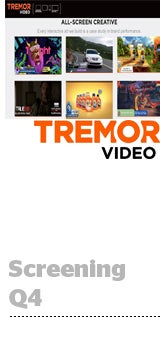 Tremor Video, the self-described premium video marketplace, said programmatic accounted for 14% of Q4 revenue (total of $41.9 million, a 15% YoY increase), and it expects more positive growth in 2015.
Tremor Video, the self-described premium video marketplace, said programmatic accounted for 14% of Q4 revenue (total of $41.9 million, a 15% YoY increase), and it expects more positive growth in 2015.
Total revenue for the year grew 21% to $159.5 million, the company revealed in its Q4 earnings Thursday. Gross margins were 36.2%, compared to 40.9% in 2013. Effective CPMs increased 12% year over year.
On the buy side, Tremor scaled up its demand-side platform (DSP), VideoHub, revealing Wednesday a preferred partner deal with agency trading desk Varick Media Management.
These deals are attractive for numerous reasons, said Tremor CEO Bill Day, since they give agencies access to “targeting, analytics and auto-optimization across its entire programmatic investment, including direct deals, the open exchange and others.”
In addition to these benefits, he claimed the agency trading desks get “third-party neutrality and an agnostic view into performance.”
Tremor also rolled out a video supply-side platform (SSP) late last year, and the company said the platform has 50 publisher partners, including USA TODAY Sports and A+E Networks.
Additionally, 10 buying platforms have been integrated with its SSP, including Adap.tv, Conversant, The Trade Desk, Google DoubleClick Bid Manager, Rocket Fuel, TubeMogul, Turn, Videology, IgnitionOne and DataXu.
“We expect our supply to continue to attract brand partners and we believe we’re the ideal partner for premium publishers as well, as they increasingly invest in programmatic,” Day said.
Tremor expects higher margins in video as marketers increasingly demand engagement-based pricing models. Day acknowledged the company had offered a performance-based pricing for years, though it’s really catching on now.“We think most people use products in the video space now that are just derivatives of the display space or optimize against a click, which makes no sense for video,” Day said. “While we can’t optimize to brand lift, we can optimize to brand impact, engagement and viewability.”
He called viewability “the most important issue currently facing our industry,” and offered the following breakdown of Tremor’s viewable allowances:
In a programmatic buy using Tremor’s DSP, a partner like Varick could choose viewability as a KPI, select either “Viewable Impression” or “Viewable Complete” and then the DSP would automatically optimize against that selection.
The ability to buy on viewable completion guarantees the ad had a better chance of achieving brand impact, Day noted.
For a guaranteed campaign (typically purchased more directly, through its sales force), Tremor enables two different models in which advertisers pay only when they’ve hit a predetermined viewability parameter – either “cost per viewable impression” or “cost per 100% viewable and 100% complete.”
Tremor’s performance-based products accounted for 32% of its revenue while its All-Screen ad product, a cross-screen campaign planning tool, represented 40% of total revenue.
Although the All-Screen tool is currently compatible with mobile devices and tablets, “there’s no reason why we can’t expand that to linear TV,” Day said on the earnings call in response to an analyst who asked if the company desired a greater share of the traditional TV ad market.














